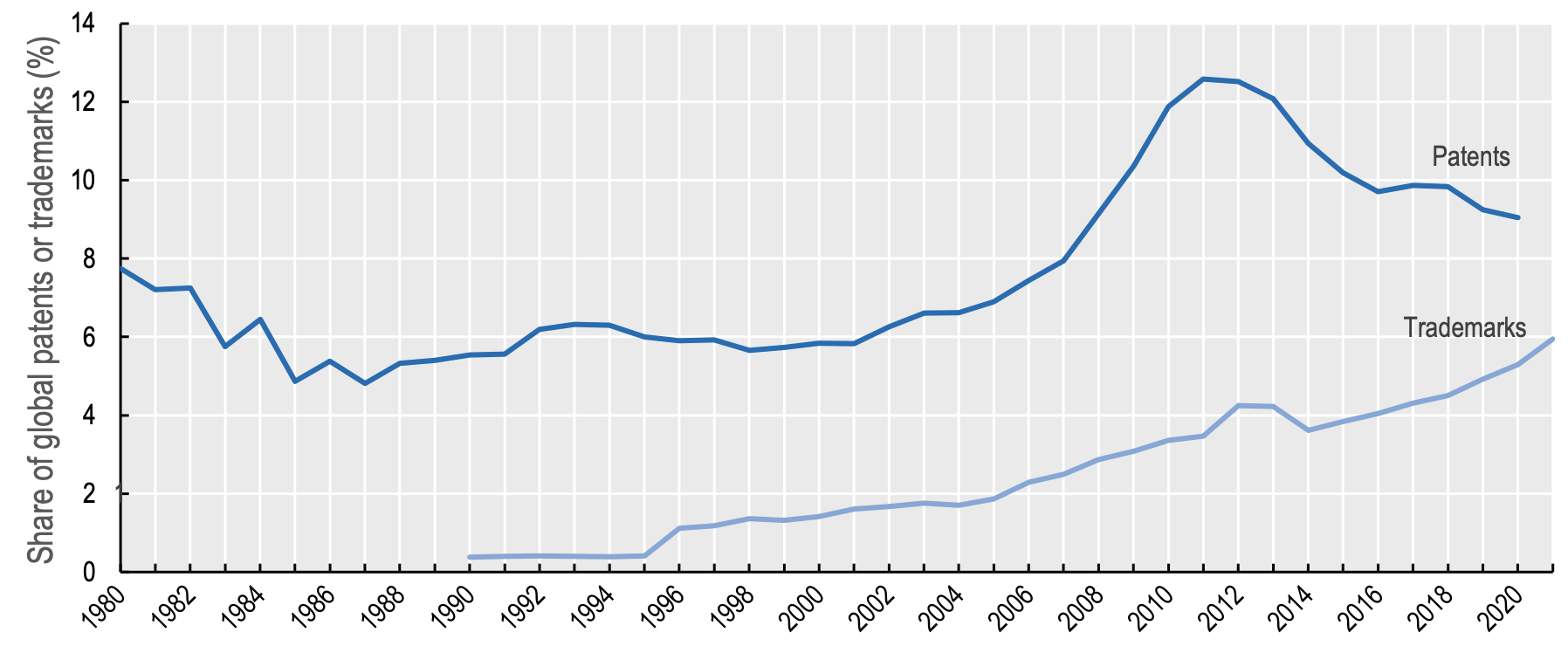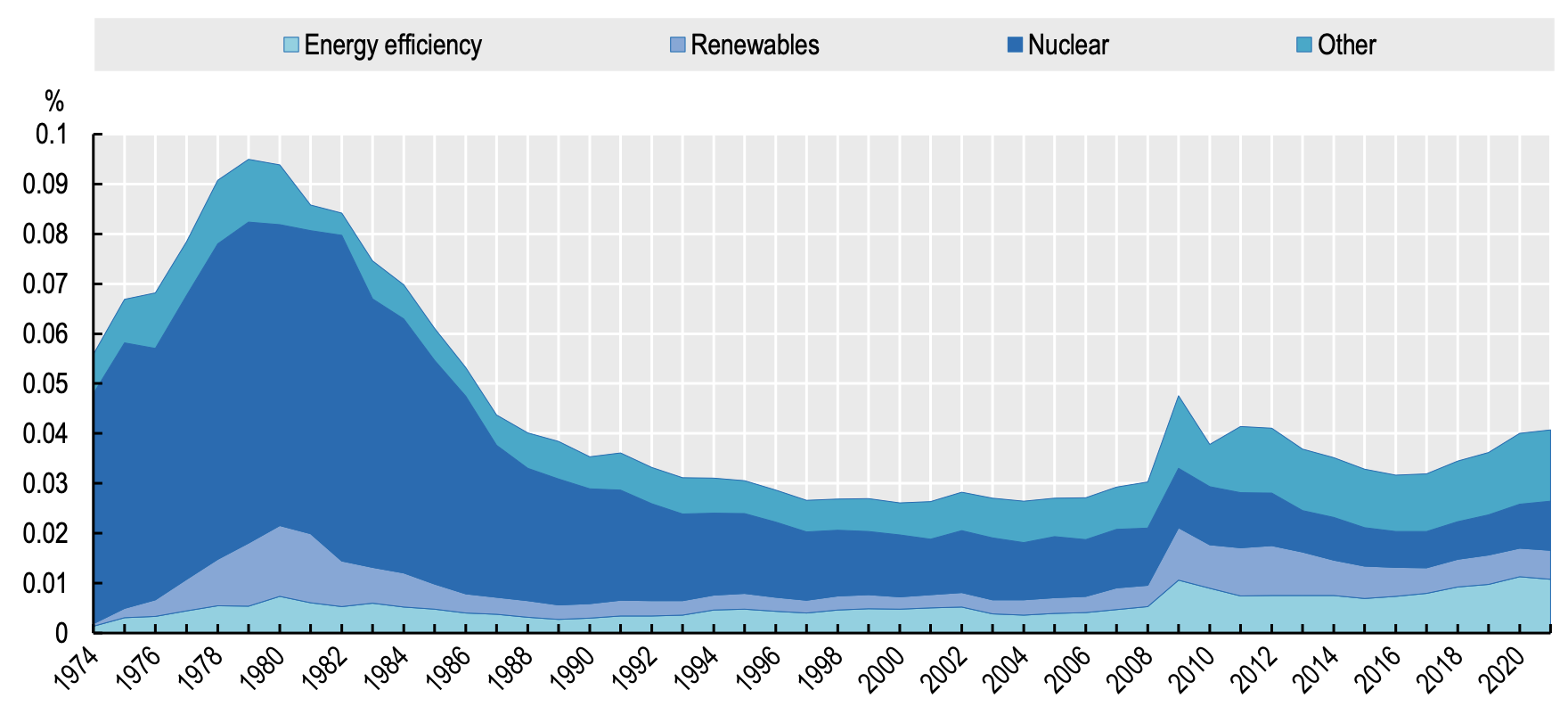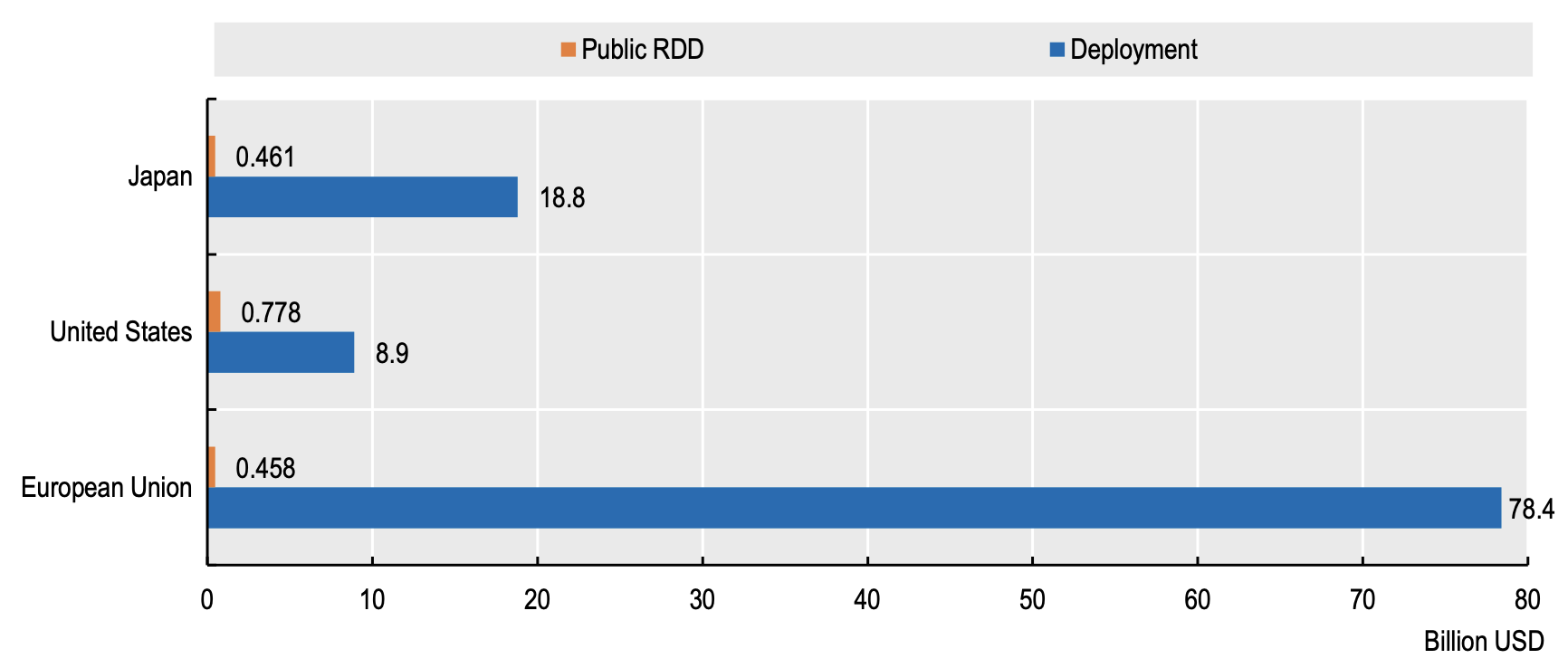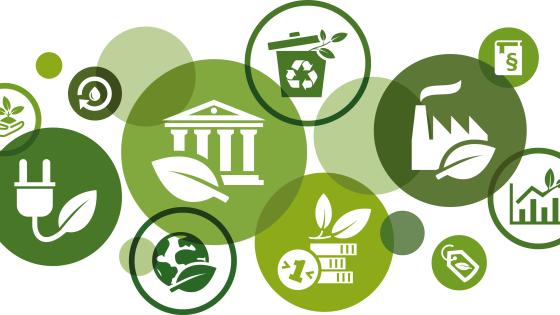Countries representing more than 90% of global GDP have now announced targets of climate neutrality by 2050 (Net Zero Stocktake 2022). Reaching these targets requires massive technological change (Van der Ploeg and Venables 2023). Further reducing the cost of mature technologies, such as renewables, will help make these fully competitive with carbon-based alternatives, allowing them to be deployed at scale. However, many other technologies, such as green hydrogen, are still in their infancy and need further development. IEA estimates that half of the global reductions in energy-related CO2 emissions through 2050 will have to come from technologies that are currently only at the prototype or demonstration phase (IEA 2021).
Low-carbon innovation is lagging and has moved from R&D to diffusion
Despite the urgency, the pace of innovation is not aligned with carbon neutrality (Cervantes et al. 2023). Over the past decade, climate-related innovation, measured as the share of patent filings in climate related technologies relative to all technologies, has slowed down (Figure 1). In contrast, the deployment of existing technologies, measured by the growth of trademark filings for climate-related goods and services, has risen. While venture capital (VC) investment in green start-ups has grown over the past decade, it has decreased since 2018 (Bioret et al. forthcoming). Moreover, VC investors appear focused on late-stage ventures, as opposed to seed investment into new ventures. Together, these trends suggest that the business sector is more focused on the diffusion and commercialisation of existing technologies than on the development of new innovations.
Figure 1 Global low-carbon patenting has declined, but climate-related trademarks continue to rise
Note: Patent data refer to families of patent applications filed under the Patent Cooperation Treaty (PCT), by earliest filing date. Trademark filings are from the European Patent Office, the US Patent and Trademark Office and the Japan Patent Office.
Source: OECD, STI Micro-data Lab: Intellectual Property Database, http://oe.cd/ipstats, February 2023.
This results from a policy emphasis on deployment rather than R&D, notably a levelling-off of concrete climate policy measures across OECD countries between 2010 and 2020, particularly for innovation-related policies (Kruse et al. 2022). Public expenditures on R&D for low-carbon technologies have remained flat (as a percentage of GDP) over the last 30 years (Figure 2), despite pledges by many countries to double clean energy R&D funding between 2016 and 2021. Recent policy actions such as the European Union member countries’ Recovery and Resilience Plans and the US Inflation Reduction Act may give a renewed impetus to such R&D.
Figure 2 Low-carbon public RD&D expenditures in GDP across IEA countries, 1974–2020
Note: The ‘Others’ category includes Carbon capture and storage, Hydrogen and fuel cells, Other power and storage technologies, and Other cross-cutting technologies and research. See https://www.iea.org/data-and-statistics/data-product/energy-technology-rd-and-d-budget-database-2
Source: IEA Energy Technology RD&D Budgets database, December 2022.
The contrast between government spending on R&D and support for deployment is striking. European countries spent €458 million in 2018 to support R&D in wind and solar power (Figure 3). The cost to society implied by subsidies for the deployment of wind and solar technologies that same year represented €78,400 million – 150 times more than public R&D. This ratio is smaller in the US and Japan, but there also the emphasis is clearly on support for deployment rather than R&D.
Figure 3 Public RD&D and deployment support in renewable energy, 2018 (bn USD)
Source: IEA Energy Technology RD&D Budgets database, December 2022; Taylor, Michael (2020), Energy subsidies: Evolution in the global energy transformation to 2050, International Renewable Energy Agency, Abu Dhabi.
Net-zero innovation policies are well justified
Given the range of barriers and market failures discouraging low-carbon innovation, the theoretical justifications for low-carbon innovation policies are well established. This includes the existence of significant social benefits from innovation in new technologies, which are particularly high for low-carbon technologies (Dechezleprêtre et al. 2014), but also learning-by-doing (Grubb et al. 2021). In addition, carbon remains largely unpriced at the global level: 60% of carbon emissions are not priced at all and the average effective carbon price is only €16.7/tonne CO2 (OECD 2022). This reduces the incentives to develop and adopt new low-carbon technologies.
Science, technology and innovation (STI) policies are critical because technological progress reduces the costs of emissions reduction policies, as demonstrated by the sharp decline in the costs of batteries and solar energy over the past decade (IPCC 2022). By reducing the cost of technology, STI policies reduce the social and economic costs of reaching climate objectives. This increases the responsiveness of emissions to carbon prices, which implies much lower carbon prices to reach the same climate target. Therefore, STI policies can partially substitute for low carbon prices, which is important as these are often difficult to implement politically. Voters strongly prefer subsidies to low-carbon technologies over other climate policies such as carbon pricing, bans or regulations (Stantcheva et al. 2022).
What can policies do?
First, governments urgently need to increase public R&D expenditures targeted at technologies that are still far from market, but necessary to reach carbon neutrality by 2050. This implies making low-carbon R&D the highest priority in governments’ research budgets and providing a long-term and stable perspective for such funding.
Governments should focus their support on technologies that are central to decarbonisation pathways and that are unlikely to be provided by the market. Carbon capture, utilisation and storage (CCUS), advanced high‐energy density batteries, hydrogen electrolysers, direct air capture, and biofuels account for a large share of emissions reductions until 2050 in all climate models, but receive only around one‐third of the level of public R&D funding of the more established low‐carbon technologies (Cervantes et al. 2023). In general, countries need to adopt a portfolio approach to diversify industrial and technology risks, thus avoiding lock-in and give all green technologies a fair chance.
Second, rebalance the use of R&D support instruments. R&D tax credits have positive effects on firms’ innovation activities, but more on experimental development than on basic and applied research (Galindo-Rueda et al. 2020). Conversely, grants have larger positive effects on the R&D stage. Horizontal R&D support has advantages, but by construction mainly benefits technologies that have the highest short-run returns. Tax credits are therefore not the right policy tool to promote new technologies that are not close to the market, such as hydrogen, justifying a stronger focus on targeted instruments.
Third, close the funding gap for large-scale demonstration projects of technologies that still have a low technology readiness level. For example, CCS demonstration projects currently cost around $1 billion (OECD 2021). The recent announcement by 16 countries at the September 2022 Clean Energy Forum to commit U$94 billion for clean energy demonstration is an important step in the right direction.
Fourth, while R&D support policies by nature target domestic firms only, deployment subsidies also benefit foreign firms. Deployment policies should therefore be designed with a clear understanding of the supply side so that they do not face constraints in the domestic economy, such as skill shortages and lack of infrastructure. Provisions limiting the foreign content of goods and services risk slowing down the climate transition, especially in the presence of shortages in the domestic economy.
Fifth, barriers to external funding should be reduced to help high-risk companies raise funds. Favourable tax schemes, low-interest or subsidised loans for young firms, and a greater mobilisation of government venture capital toward the green transition can help.
Sixth, collaboration in low-carbon innovation should be strengthened. There is ample room for improvement in collaborative R&D, between firms, between firms and public research institutions and between countries, to capitalise on complementary skills and resources at the domestic and international levels. Coordinated action can accelerate innovation, enhance economies of scale, strengthen incentives for investment, and foster a level playing field where needed.
Finally, low-carbon innovation policies need to be embedded in a broader package. Carbon pricing and the removal of fossil fuel subsidies are necessary to encourage the adoption of clean technologies that are closer to market and help ‘redirect’ innovation toward low-carbon activities. For example, the introduction of the European carbon market (EU ETS) led to a large and rapid increase in low-carbon innovation among regulated companies (Calel and Dechezleprêtre 2016).
The low-carbon transition will involve a massive structural transformation that will require the alignment of policy frameworks beyond STI and climate policies. Competition and entrepreneurship policies play a critical role in encouraging business dynamism and the reallocation of resources. Education and skills policies can help develop skills for the transformation and helps workers adjust to structural change. An efficient and cost-effective shift to a low-carbon economy thus requires the engagement of many parts of government beyond those traditionally mobilised in the development of climate change policies.
References
Bioret, L, A Dechezleprêtre and P Sarapatkova (forthcoming), “The new green economy: Venture capital, innovation and business success in cleantech startups”, OECD Science, Technology and Industry Policy Papers.
Calel, R and A Dechezleprêtre (2016), “Environmental policy and directed technological change: Evidence from the European carbon market”, Review of Economics and Statistics 98(1): 173–91.
Cervantes, M, C Criscuolo, A Dechezleprêtre and D Pilat (2023), “Driving low-carbon innovations for climate neutrality”, OECD Science, Technology and Industry Policy Papers No. 143.
Dechezleprêtre, A, R Martin and M Mohnen (2014), “Knowledge spillovers from clean and dirty technologies”, CEP Discussion Papers No. 1300.
Galindo-Rueda, F, M Bajgar, C Criscuolo and S Appelt (2020), “Effectiveness of R&D tax incentives in OECD economies”, VoxEU.org, 14 October.
Grubb, M, et al. (2021), “Induced innovation in energy technologies and systems: A review of evidence and potential implications for CO2 mitigation”, Environmental Research Letters 16(4): 043007.
IEA (2021), Net zero by 2050: A roadmap for the global energy sector, OECD Publishing.
IPCC (2022), Climate change 2022: Mitigation of climate change. Contribution of Working Group III to the sixth assessment report of the Intergovernmental Panel on Climate Change.
Kruse, T, et al. (2022), “Measuring environmental policy stringency in OECD countries: An update of the OECD composite EPS indicator”, OECD Economics Department Working Papers No. 1703.
OECD (2021), Policies for a carbon-neutral industry in the Netherlands, OECD Publishing.
OECD (2022), Effective carbon rates 2021: Pricing carbon emissions through taxes and emissions trading, OECD Publishing.
van der Ploeg, F, and A Venables (2023), “Radical climate policies”, VoxEU.org, 25 February.
Stantcheva, S, A S Chico, B Planterose, T Kruse, A Fabre and A Dechezleprêtre (2022), “Fighting climate change: International attitudes toward climate policies”, VoxEU.org, 14 October.










